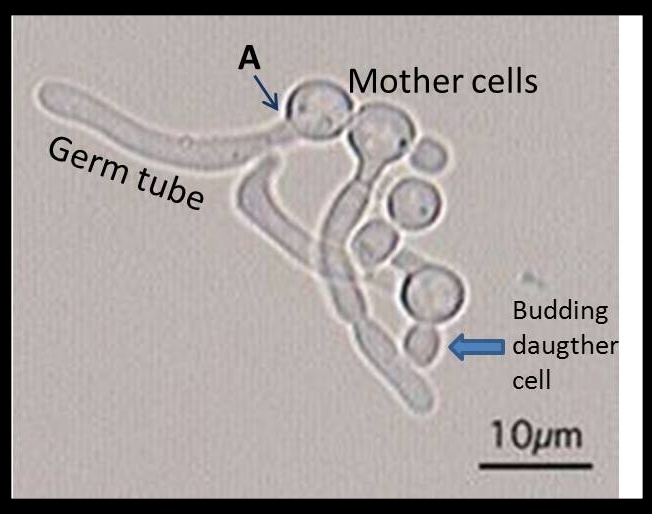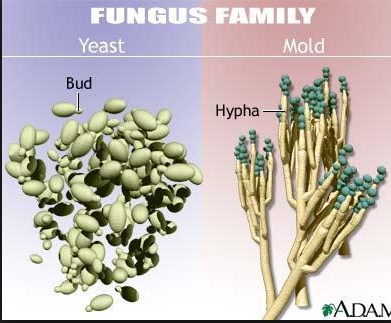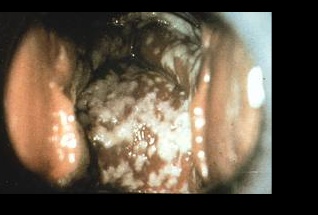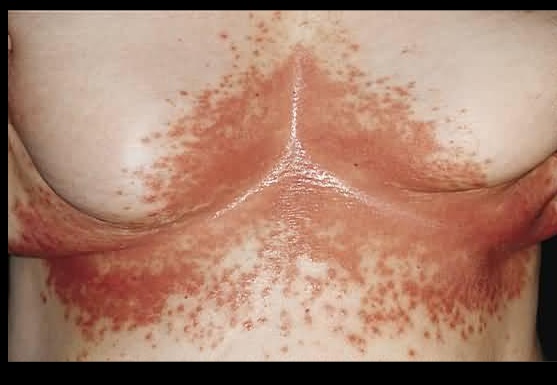Candida Albicans
_ is an opportunistic dimorphic fungus that grows as budding yeast cells, pseudohyphae, true hyphae, or spores. Pseudohyphae are distinguished from true hyphae by the lack of cytoplasmic connection between cells and relative frailty.
For most dimorphic fungi, the mnemonic "mold = cold, yeast = heat" applies. C. albicans is unusual because the mold form grows at 37°C while the yeast form (pseudohyphae and budding yeasts) predominates at 20°C.
Butterfly morphs 
Germ tube test
_A diagnostic test where a sample of fungal spores are suspended in serum and examined by microscopy for germ tubes, which is an outgrowth produced by spores from fungi during germination. A positive germ tube test is strongly indicative of C. albicans.
Germ tube= true hyphae
Snow cones at 37, ice balls at 20

_ Normal mold = hyphae = cold yeast = budding = hot
Candida
mold = hyphae = hot
yeast = budding = cold 
Normal habitat
_Found in the mucous membranes of respiratory, GI, and female genital tracts, with tendencies to overgrow in warm, moist areas.
Part of the normal flora may contaminate sputum cultures
Overgrowth
_Can lead to:
Oral thrush of the mouth that appears as a white exudate on mucous membranes.
mmunocompromised or steroid usage
KOH: used for scraping prep
Adult scraping the snow

Vaginitis that presents with itching, copious secretion, and “cottage cheese” appearing clumps.

Cutaneous candidiasis can present as a beefy red rash with satellite pustular lesions in moist intertriginous areas (where two skin areas touch) such as under the breasts, axilla of the arm, or anogenital region. This can also manifest as a diaper rash in infants.

Red diper. Heat and humidity.

Oral candidiasis risk
_Use steroids: Little boy with blue steroid inhaler
Use steroids without rinsing the equipment 
Vaginitis risks
Candies: diabetes
Drugs: Antibiotics
Birth control pills all risks for candida
Teacher getting hit:

_Vaginitis typically presents with a normal vaginal pH less than 4.5 versus bacterial vaginosis or trichomonal vaginitis, where vaginal pH may be higher than 4.5.
Open until 4pH 
_Oral thrush presents as white plaques that can be removed or scraped away. Contrast this with hairy leukoplakia, a manifestation of EBV also present in AIDS patients, which presents as white plaques on the side of the tongue that cannot be scraped off.
_In immunocompromised individuals, persistent infection can spread and lead to esophagitis and disseminated candidiasis, which may lead to infective endocarditis.
Pink slides with white snow. Pseudomembrane formation 
Endocarditis
_ 3 mountains with hearts: tricuspid valve
Commonly seen in IV drug users (in heroine)
First valve drug goes to 
_Candida esophagitis presents as retrosternal pain upon swallowing is considered an AIDS-defining illness. Oral thrush is not considered AIDS-defining.
Starts seeing at CD4<100
Max 100 lbs 
_T-cell deficient patients are more likely to get superficial Candida infections, whereas neutropenic patients are more likely to have disseminated candidiasis (hematogenous).
Catalase positive cat. CGD: disseminated 
Treatment
_Treatment include:
Nystatin mouthwash and oral fluconazole for thrush and esophagitis
Topical azoles or oral fluconazole for vaginitis
Oral fluconazole or any IV echinocandins for disseminated candidiasis. Pinecones for conazoles Play Nyce for oral Frogs, amphibians for immunocompromised Cap on elderly: capsofungin for immunocompromised

Last updated
Was this helpful?